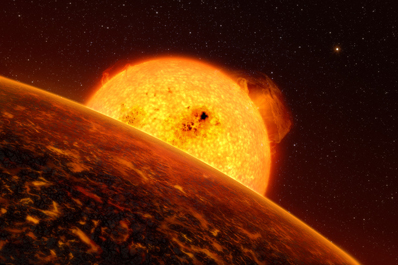


|

|
 |
|
Rocky exo-world breaks new records KEITH COOPER ASTRONOMY NOW Posted: September 16, 2009 A small planet 500 light years away has been found to be the fastest moving planet known, whizzing around its star once every 20.4 hours. To orbit so quickly the planet, known as CoRoT-7b, must be only 2.5 million kilometres from its sun. It is the first planet to be unambiguously confirmed as a rocky planet.  An artist's impression of CoRoT-7b, a molten, rocky world incredibly close to its star, where temperatures could reach 2,000 degrees Celsius in the daytime. Image: ESO/L Calcada.
An artist's impression of CoRoT-7b, a molten, rocky world incredibly close to its star, where temperatures could reach 2,000 degrees Celsius in the daytime. Image: ESO/L Calcada.
CoRoT-7b is one of a currently rare breed of exoplanets with masses just a few times that of Earth’s. It was discovered transiting its star – an obscure sun previously known as TYC 4799-1733-1 but now raised to prominence as CoRoT-7 – in February by the French-led stellar seismology and planet-hunting spacecraft CoRoT (which stands for Convection, Rotation and planetary Transits). CoRoT is designed to stare at stars and determine their inner structures from the acoustic waves that ripple across their surfaces, but as CoRoT stares at these stars, it can also see planets passing (transiting) in front of them, blocking some of the starlight. The dip in starlight caused by CoRoT-7b is just one part in 3,000. From the transit, scientists were able to calculate that the exoplanet’s diameter is about 22,900 kilometres (80 percent greater than Earth’s diameter). That’s small enough to be a rocky planet, but it was impossible to be sure without measuring its mass, and therefore working out its density. To calculate the mass of CoRoT-7b, astronomers had to measure how much its gravity was causing its star to wobble. Detecting wobbles in stars is a leading method of finding large exoplanets, but detecting the wobble caused by a smaller planet is another matter. To do this, astronomers utilised the High Accuracy Radial velocity Planet Searcher (HARPS) spectrograph on the 3.5-metre telescope at the European Southern Observatory’s site in La Silla, Chile. HARPS is the world’s most successful instrument for finding low mass planets, and it took an unprecedented 70 hours of observations to pin down the wobble in CoRoT-7 and work out the mass of CoRoT-7b. This was found to be five Earth masses, and its density equivalent to a rocky planet. Part of the difficulty encountered when making the measurements with HARPS was the presence of a plague of starspots, like sunspots, on the surface of CoRoT-7. The star is only 1.5 billion years old (compared to the Sun’s age of 4.6 billion years) and younger stars spin faster and have larger starspots (see our related story here). “The presence of starspots generates a scattering in the radial velocity signal because dark spots on a rotating surface will modify the profile of the stellar absorption lines used in the radial velocity measurement,” says one of the researchers, Clare Moutou of the Laboratoire d’Astrophysique de Marseille. In other words, they produce interference that only HARPs could cut through. HARPS also threw up an additional surprise – a second planet orbiting the star, called CoRot-7c. With a mass eight times that of Earth, it orbits the star every three days and 17 hours. Although there are several planets suspected of being less massive than CoRoT-7b and equally rocky, such as a trio of worlds in the Gliese 581 system, the pulsar planets discovered in 1992, and MOA-2007-BLG-192Lb which was spotted in a one-off gravitational microlensing event, CoRoT-7b is nevertheless the first small exoplanet to have had its properties measured to such an accurate degree via both transits and radial velocity measurements. It is also the closest planet to a star ever found, 23 times closer than Mercury is to the Sun. According to Moutou, it is likely that both planets formed further away from their star, before migrating inwards. It is expected that NASA’s Kepler spacecraft, which launched in March, will find hundreds or perhaps even thousands of rocky, low mass worlds over the next few years. CoRoT-7b is just the start. |
|
|
|
|